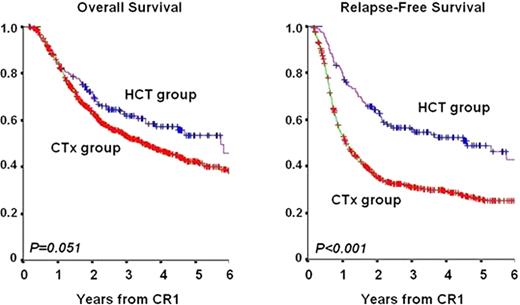Abstract
Abstract 524
The benefits of allogeneic hematopoietic cell transplantation (allo-HCT) for patients with acute myeloid leukemia (AML) in first complete remission (CR1) have mostly been evaluated in related younger donor/patient pairs by allocating treatment options based on donor availability. However, the benefits of allo-HCT in elderly patients have not been fully elucidated. To overcome an increased risk of non-relapse mortality (NRM) in elderly patients, reduced-intensity conditioning (RIC) regimens have been developed. We performed a nationwide retrospective survey to address recent optimal post-remission strategies for elderly AML patients stratified according to risk factors such as cytogenetic risks.
We collected data from adult patients aged 50 to 70 years who were diagnosed with AML between 1999 and 2006, and who achieved CR1 after 1 or 2 courses of induction chemotherapy.
After we excluded patients with M3 or those who received autologous HCT during CR1, a total of 1,036 patients from 67 centers were eligible for this analysis. The median follow-up of the surviving patients was 1,323 days. The proportions of patients with favorable, intermediate, unfavorable and unknown cytogenetic risks by SWOG criteria were 16%, 60%, 16% and 9%, respectively. Therapies performed at CR1 were allo-HCT in 152 patients (HCT-group, 15%) and chemotherapy in 884 patients (CTx group, 85%). Of the 884 patients who did not receive allo-HCT, 46 relapsed or died within 2 months after achieving CR1; they were excluded from the landmark analysis. Donor sources for HCT in CR1 were HLA-matched related (42%), mismatched related (9%), unrelated bone marrow (34%), or unrelated cord blood (15%). The median ages of patients conditioned with myeloablative (38%) and reduced-intensity (62%) conditioning regimens were 52 (range, 50-59) and 58 (range, 50-70) years, respectively. In the landmark analysis, the relapse rate (RR) in the HCT group was significantly lower than that in the CTx group (27% vs. 68% at 3 years, p<0.0001). Although a similar trend was seen in each cytogenetic risk group, unfavorable-risk AML patients had a high RR even after allo-HCT (50% at 3 years). NRM was higher in the HCT group than in the CTx group (23% vs. 3% at 3 years), with no significant difference among cytogenetic risks. The 3-year relapse-free survival (RFS) was significantly higher in the HCT group than in the CTx group (56% vs 31%, p<0.001). In addition, the 3-year overall survival (OS) in the HCT group tended to be higher than that in the CTx group (62% vs 53%, p=0.051). The benefit of allo-HCT in CR1 was more clearly observed in patients with AML other than favorable cytogenetic risk (OS: 61% vs 51%, p=0.036). Multivariate analyses for survival showed that allo-HCT, a single course of induction therapy to achieve CR1, lack of dysplasia, WBC on diagnosis below 20,000/μl, and more favorable cytogenetic risk were significantly associated with better RFS and OS.
Our data suggest that allo-HCT is effective for reducing the incidence of relapse after CR1 in elderly patients with AML. This benefit was observed not only in RFS but also in OS, especially in patients with AML other than favorable risk, which may be explained by recent improvements in peri-transplant supportive procedures and the introduction of RIC.
No relevant conflicts of interest to declare.
Author notes
Asterisk with author names denotes non-ASH members.


This feature is available to Subscribers Only
Sign In or Create an Account Close Modal